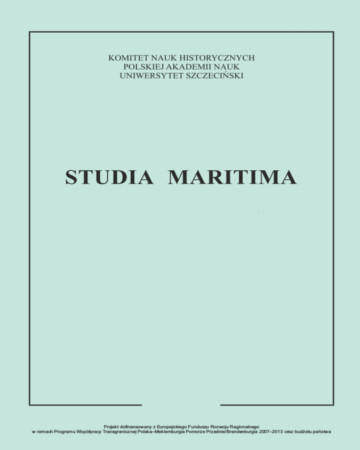






| Authors: |
Aleksandra
Bartosiewicz

Uniwersytet łódzki |
| Keywords: | DCT Gdańsk maritime container terminal history |
| Data publikacji całości: | 2019 |
| Page range: | 16 (259-274) |
| 1. | Adamowicz, Magdalena. “Głębokowodny terminal kontenerowy DCT w Gdańsku. Geneza i realizacja inwestycji.” Contemporary Economy 7 (2016): 91–108. |
| 2. | Bałtyckie porty tracą w wyniku wojny ekonomicznej między UE a Rosją. Morza |
| 3. | i Oceany. Accessed 13.01.2019. http://morzaioceany.pl/inne/archiwum/14-porty- morskie/2992-ba%C5%82tyckie-porty-trac%C4%85-w-wyniku-wojny-ekonomicznej- mi%C4%99dzy-ue-a-rosj%C4%85.html. |
| 4. | Bartosiewicz, Aleksandra. “Organizacja procesów wyładowczych na terminalu Euromax w Rotterdamie.” In: Metody i zastosowania badań operacyjnych w gospodarce, finansach i szkolnictwie wyższym, ed. Wojciech Sikora, 7–21. Poznań: Wydawnictwo Uniwersytetu Ekonomicznego w Poznaniu, 2013. |
| 5. | Bartosiewicz, Aleksandra. “Terminal operating systems as a tool to support entrepreneurship and competitiveness of sea ports.” Przedsiębiorczość i Zarządzanie |
| 6. | 15 (2014): 175–187. |
| 7. | Bartosiewicz, Aleksandra. “The role of maritime container terminals in the provision of logistics services.” Zeszyty Naukowe Uniwersytetu Przyrodniczo-Humanistycznego w Siedlcach 104 (2015): 17–26. |
| 8. | Christerson, Markus. “Meeting the demands of larger vessels with larger and faster cranes.” Port Technology International 40 (2011): 1–3. |
| 9. | DCT Gdańsk potroi moce przeładunkowe dzięki rozbudowanej bocznicy. Izba Gospodarcza Transportu Lądowego. Accessed 10.01.2019. https://igtl.pl/node/1420. |
| 10. | DCT testuje nowe suwnice STS. DCT Gdańsk. Accessed 01.10.2013. http://dctgdansk.pl/pl/ dct-tests-its-new-sts-cranes/. |
| 11. | Drugie nabrzeże kontenerowe DCT Gdańsk (T2) uruchomione. Logistyka a Jakość. Accessed 10.01.2019. http://laj.pl/transport/3301/drugie_nabrzeze_kontenerowe_dct_ |
| 12. | gdansk_t2_uruchomione/. |
| 13. | Dzwonnik, Maciej. Terminal kontenerowy DCT Gdańsk bije rekordy i chce być jeszcze większy. Wyborcza.pl. Accessed 10.01.2019. http://trojmiasto.wyborcza.pl/trojmiasto/ 7, 3 5 6 1 2 , 2 2 9 3 9 4 8 2 , t e r m i n a l - k o n t e n e r o w y - d c t - g d a n s k - b i j e - r e k o r d y - i - c h c e - b y c - j e s z c z e . html?disableRedirects=true. |
| 14. | Grzelakowski, Andrzej S. “Rozwój rynku przewozów intermodalnych w Polsce i jego wpływ na portowy rynek kontenerowy.” Logistyka 2 (2014): 13–22. |
| 15. | Historia. DCT Gdańsk. Accessed 21.01.2019. https://dctgdansk.pl/pl/about-dct/history/. Kim, Kap Hwan, Hans-Otto Guenther. Container terminals and cargo systems. Design, |
| 16. | operations management and logistics control issues. Berlin-Heidelberg: Springer, 2007. |
| 17. | Konkurencyjność polskich portów kontenerowych. Morza i Oceany. Accessed 13.01.2019. http://morzaioceany.pl/porty-morskie/port-gdansk/87-konkurencyjnosc-polskich- portow-kontenerowych.html. |
| 18. | Kujawa, Jerzy. Organizacja i technika transportu morskiego. Gdańsk: Wydawnictwo Uniwersytetu Gdańskiego, 1997. |
| 19. | Milewski, Radosław. “Planowanie procesów ładunkowych uzbrojenia i sprzętu wojskowego w ruchu morskim.” Zeszyty Naukowe Wyższa Szkoła Oficerska Wojsk Lądowych 4 (2010): 185–199. |
| 20. | Nowe alianse armatorskie w 2017. Nautiqus. Accessed 15.01.2019. https://www.nautiqus.pl/ nowe-alianse-armatorskie-w-2017,129,pl.html. |
| 21. | PFR kupił port DCT Gdańsk. Puls Biznesu. Accessed 27.03.2019. https://www.pb.pl/pfr- kupil-port-dct-956185. |
| 22. | Pomorskie Centrum Logistyczne – powstał kolejny magazyn. Logistyka.wnp.pl. Accessed 10.01.2019. https://logistyka.wnp.pl/pomorskie-centrum-logistyczne-powstal-kolejny- |
| 23. | magazyn,300729_1_0_0.html. |
| 24. | Productivity soars as throughput increases. DCT Gdańsk. Accessed 01.10.2013. http://dctgdansk.pl/pl/productivity-soars-as-throughput-increases/. |